Job Designing Approaches for CERA
VerifiedAdded on 2023/01/23
|17
|4614
|72
AI Summary
This report discusses the changing trends in the workplace and the constant changing programs for CERA. It also explores the major approaches for job designing and suggests the suitable approach for the organization. The report emphasizes the importance of job design in enhancing employee motivation and performance.
Contribute Materials
Your contribution can guide someone’s learning journey. Share your
documents today.

Running head: HUMAN RESOURCE MANAGEMENT
Human Resource Management: CERA
Name of the Student
Name of the University
Author’s Note:
Human Resource Management: CERA
Name of the Student
Name of the University
Author’s Note:
Secure Best Marks with AI Grader
Need help grading? Try our AI Grader for instant feedback on your assignments.
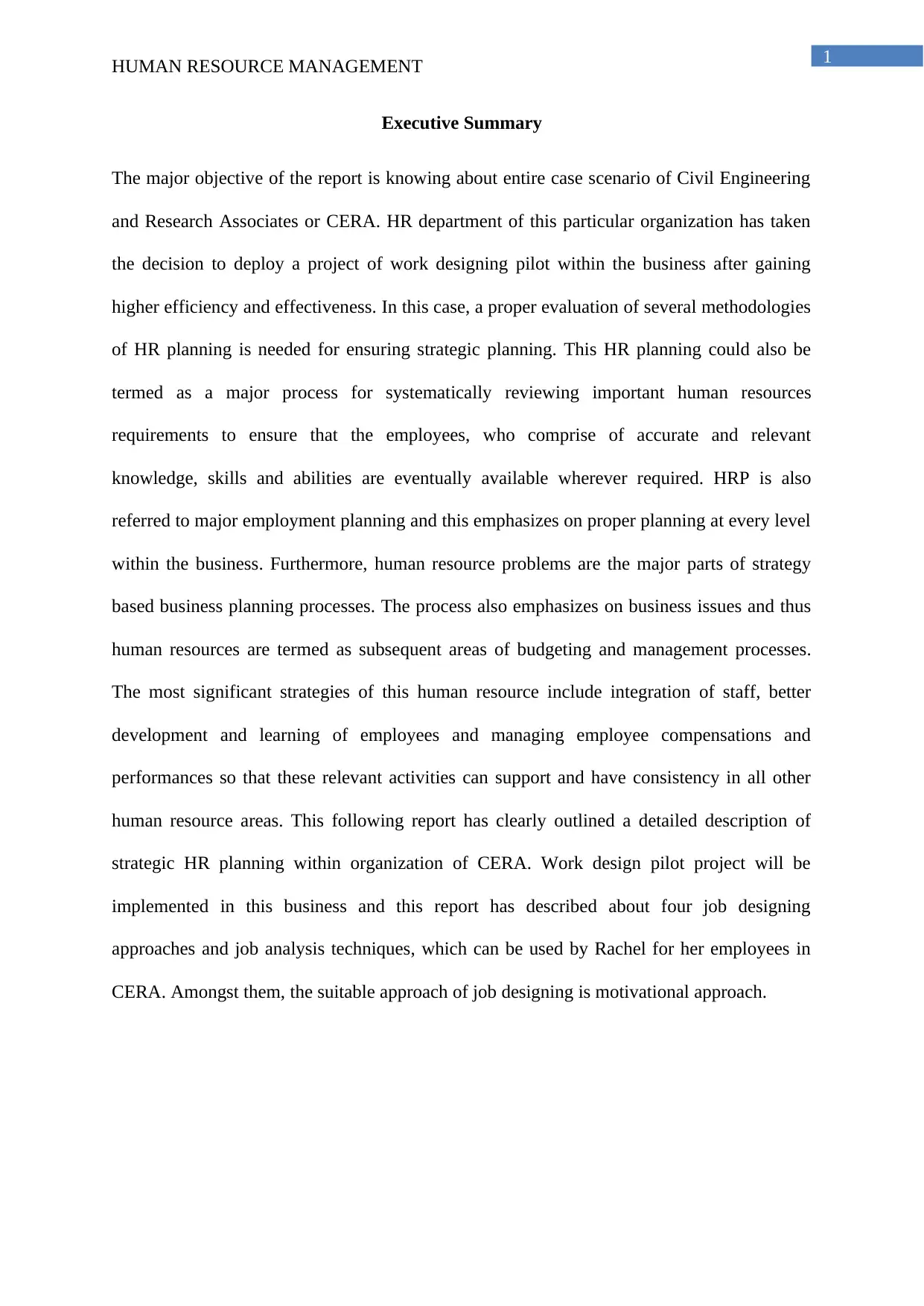
1
HUMAN RESOURCE MANAGEMENT
Executive Summary
The major objective of the report is knowing about entire case scenario of Civil Engineering
and Research Associates or CERA. HR department of this particular organization has taken
the decision to deploy a project of work designing pilot within the business after gaining
higher efficiency and effectiveness. In this case, a proper evaluation of several methodologies
of HR planning is needed for ensuring strategic planning. This HR planning could also be
termed as a major process for systematically reviewing important human resources
requirements to ensure that the employees, who comprise of accurate and relevant
knowledge, skills and abilities are eventually available wherever required. HRP is also
referred to major employment planning and this emphasizes on proper planning at every level
within the business. Furthermore, human resource problems are the major parts of strategy
based business planning processes. The process also emphasizes on business issues and thus
human resources are termed as subsequent areas of budgeting and management processes.
The most significant strategies of this human resource include integration of staff, better
development and learning of employees and managing employee compensations and
performances so that these relevant activities can support and have consistency in all other
human resource areas. This following report has clearly outlined a detailed description of
strategic HR planning within organization of CERA. Work design pilot project will be
implemented in this business and this report has described about four job designing
approaches and job analysis techniques, which can be used by Rachel for her employees in
CERA. Amongst them, the suitable approach of job designing is motivational approach.
HUMAN RESOURCE MANAGEMENT
Executive Summary
The major objective of the report is knowing about entire case scenario of Civil Engineering
and Research Associates or CERA. HR department of this particular organization has taken
the decision to deploy a project of work designing pilot within the business after gaining
higher efficiency and effectiveness. In this case, a proper evaluation of several methodologies
of HR planning is needed for ensuring strategic planning. This HR planning could also be
termed as a major process for systematically reviewing important human resources
requirements to ensure that the employees, who comprise of accurate and relevant
knowledge, skills and abilities are eventually available wherever required. HRP is also
referred to major employment planning and this emphasizes on proper planning at every level
within the business. Furthermore, human resource problems are the major parts of strategy
based business planning processes. The process also emphasizes on business issues and thus
human resources are termed as subsequent areas of budgeting and management processes.
The most significant strategies of this human resource include integration of staff, better
development and learning of employees and managing employee compensations and
performances so that these relevant activities can support and have consistency in all other
human resource areas. This following report has clearly outlined a detailed description of
strategic HR planning within organization of CERA. Work design pilot project will be
implemented in this business and this report has described about four job designing
approaches and job analysis techniques, which can be used by Rachel for her employees in
CERA. Amongst them, the suitable approach of job designing is motivational approach.
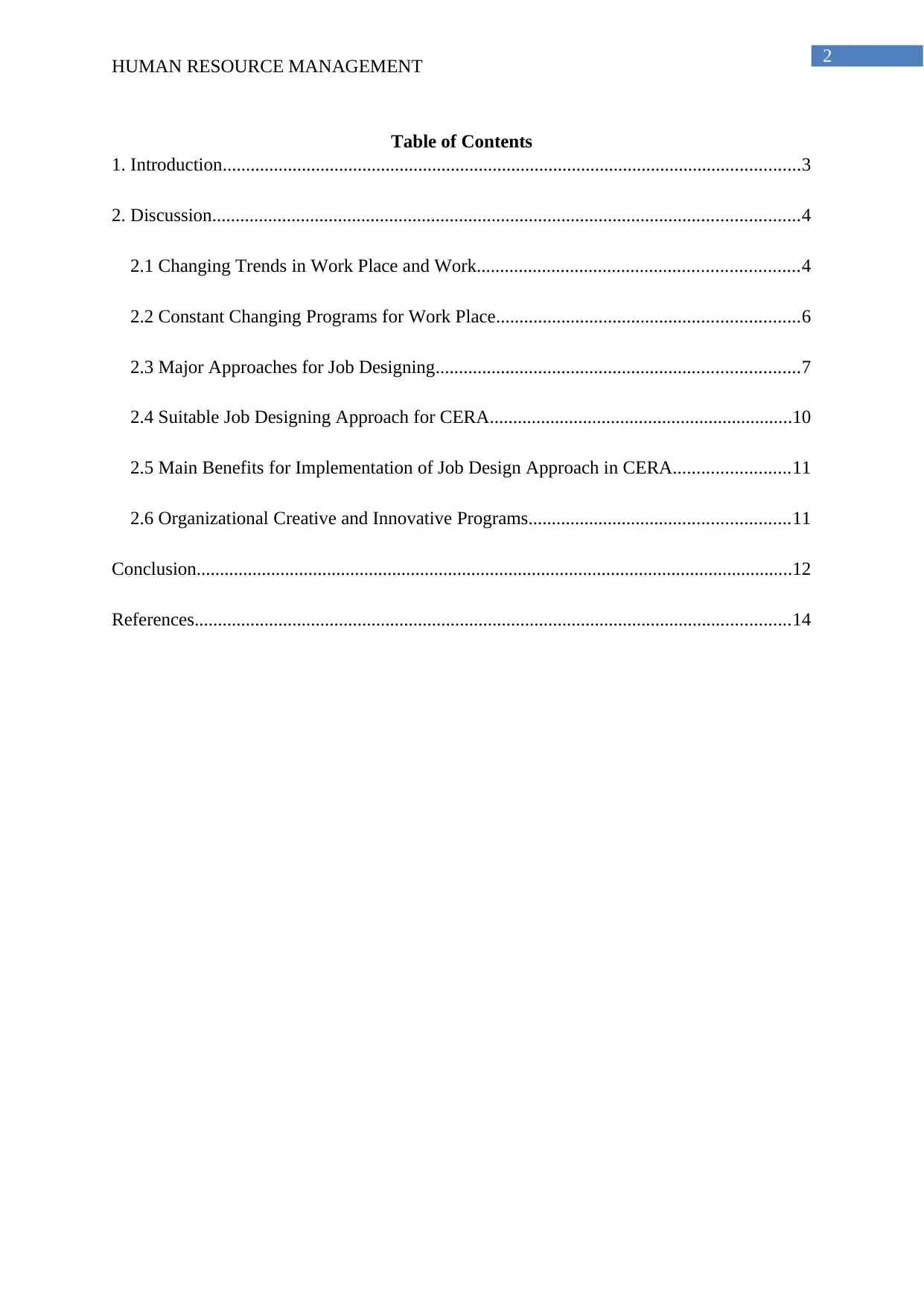
2
HUMAN RESOURCE MANAGEMENT
Table of Contents
1. Introduction............................................................................................................................3
2. Discussion..............................................................................................................................4
2.1 Changing Trends in Work Place and Work.....................................................................4
2.2 Constant Changing Programs for Work Place.................................................................6
2.3 Major Approaches for Job Designing..............................................................................7
2.4 Suitable Job Designing Approach for CERA.................................................................10
2.5 Main Benefits for Implementation of Job Design Approach in CERA.........................11
2.6 Organizational Creative and Innovative Programs........................................................11
Conclusion................................................................................................................................12
References................................................................................................................................14
HUMAN RESOURCE MANAGEMENT
Table of Contents
1. Introduction............................................................................................................................3
2. Discussion..............................................................................................................................4
2.1 Changing Trends in Work Place and Work.....................................................................4
2.2 Constant Changing Programs for Work Place.................................................................6
2.3 Major Approaches for Job Designing..............................................................................7
2.4 Suitable Job Designing Approach for CERA.................................................................10
2.5 Main Benefits for Implementation of Job Design Approach in CERA.........................11
2.6 Organizational Creative and Innovative Programs........................................................11
Conclusion................................................................................................................................12
References................................................................................................................................14
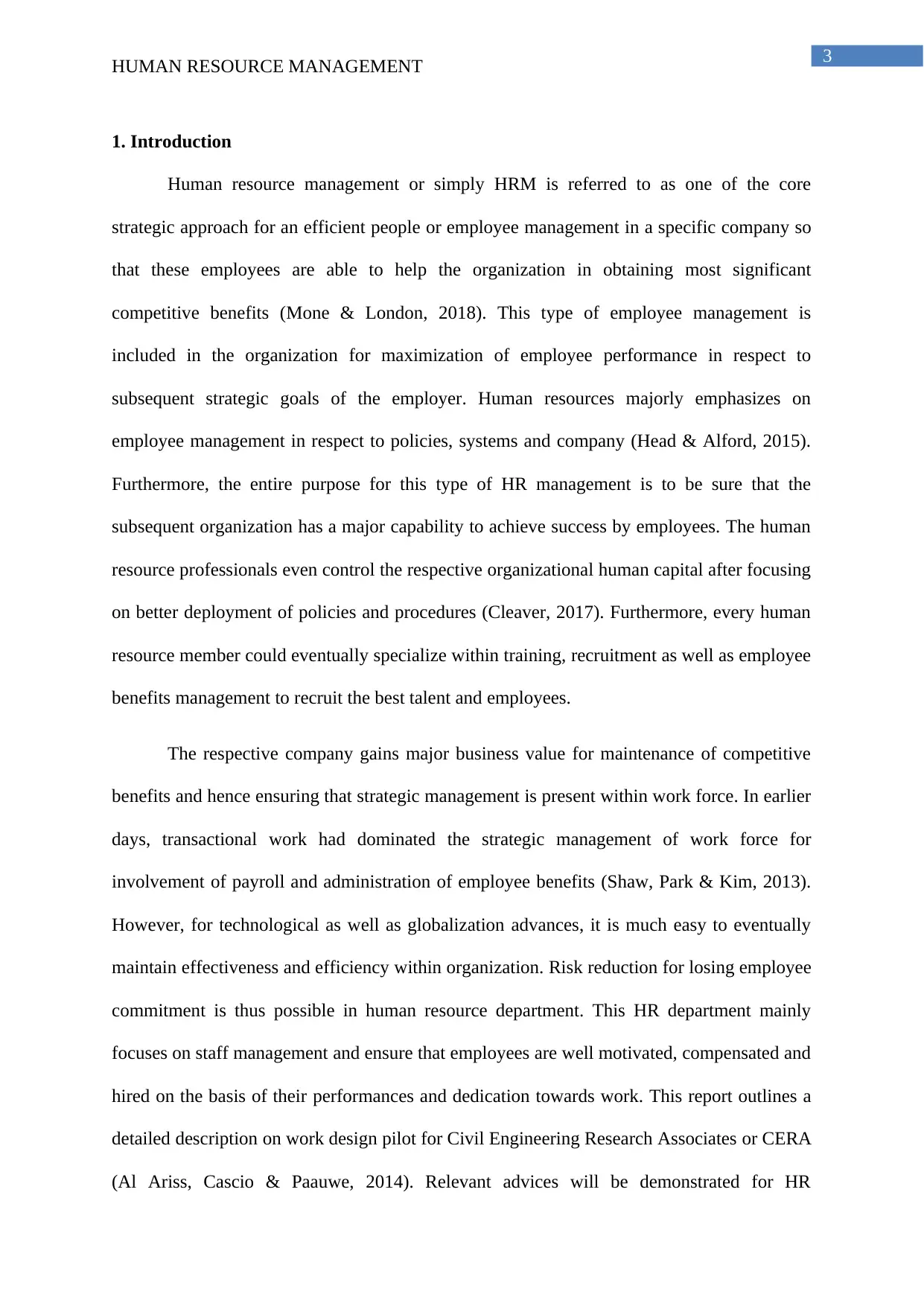
3
HUMAN RESOURCE MANAGEMENT
1. Introduction
Human resource management or simply HRM is referred to as one of the core
strategic approach for an efficient people or employee management in a specific company so
that these employees are able to help the organization in obtaining most significant
competitive benefits (Mone & London, 2018). This type of employee management is
included in the organization for maximization of employee performance in respect to
subsequent strategic goals of the employer. Human resources majorly emphasizes on
employee management in respect to policies, systems and company (Head & Alford, 2015).
Furthermore, the entire purpose for this type of HR management is to be sure that the
subsequent organization has a major capability to achieve success by employees. The human
resource professionals even control the respective organizational human capital after focusing
on better deployment of policies and procedures (Cleaver, 2017). Furthermore, every human
resource member could eventually specialize within training, recruitment as well as employee
benefits management to recruit the best talent and employees.
The respective company gains major business value for maintenance of competitive
benefits and hence ensuring that strategic management is present within work force. In earlier
days, transactional work had dominated the strategic management of work force for
involvement of payroll and administration of employee benefits (Shaw, Park & Kim, 2013).
However, for technological as well as globalization advances, it is much easy to eventually
maintain effectiveness and efficiency within organization. Risk reduction for losing employee
commitment is thus possible in human resource department. This HR department mainly
focuses on staff management and ensure that employees are well motivated, compensated and
hired on the basis of their performances and dedication towards work. This report outlines a
detailed description on work design pilot for Civil Engineering Research Associates or CERA
(Al Ariss, Cascio & Paauwe, 2014). Relevant advices will be demonstrated for HR
HUMAN RESOURCE MANAGEMENT
1. Introduction
Human resource management or simply HRM is referred to as one of the core
strategic approach for an efficient people or employee management in a specific company so
that these employees are able to help the organization in obtaining most significant
competitive benefits (Mone & London, 2018). This type of employee management is
included in the organization for maximization of employee performance in respect to
subsequent strategic goals of the employer. Human resources majorly emphasizes on
employee management in respect to policies, systems and company (Head & Alford, 2015).
Furthermore, the entire purpose for this type of HR management is to be sure that the
subsequent organization has a major capability to achieve success by employees. The human
resource professionals even control the respective organizational human capital after focusing
on better deployment of policies and procedures (Cleaver, 2017). Furthermore, every human
resource member could eventually specialize within training, recruitment as well as employee
benefits management to recruit the best talent and employees.
The respective company gains major business value for maintenance of competitive
benefits and hence ensuring that strategic management is present within work force. In earlier
days, transactional work had dominated the strategic management of work force for
involvement of payroll and administration of employee benefits (Shaw, Park & Kim, 2013).
However, for technological as well as globalization advances, it is much easy to eventually
maintain effectiveness and efficiency within organization. Risk reduction for losing employee
commitment is thus possible in human resource department. This HR department mainly
focuses on staff management and ensure that employees are well motivated, compensated and
hired on the basis of their performances and dedication towards work. This report outlines a
detailed description on work design pilot for Civil Engineering Research Associates or CERA
(Al Ariss, Cascio & Paauwe, 2014). Relevant advices will be demonstrated for HR
Paraphrase This Document
Need a fresh take? Get an instant paraphrase of this document with our AI Paraphraser
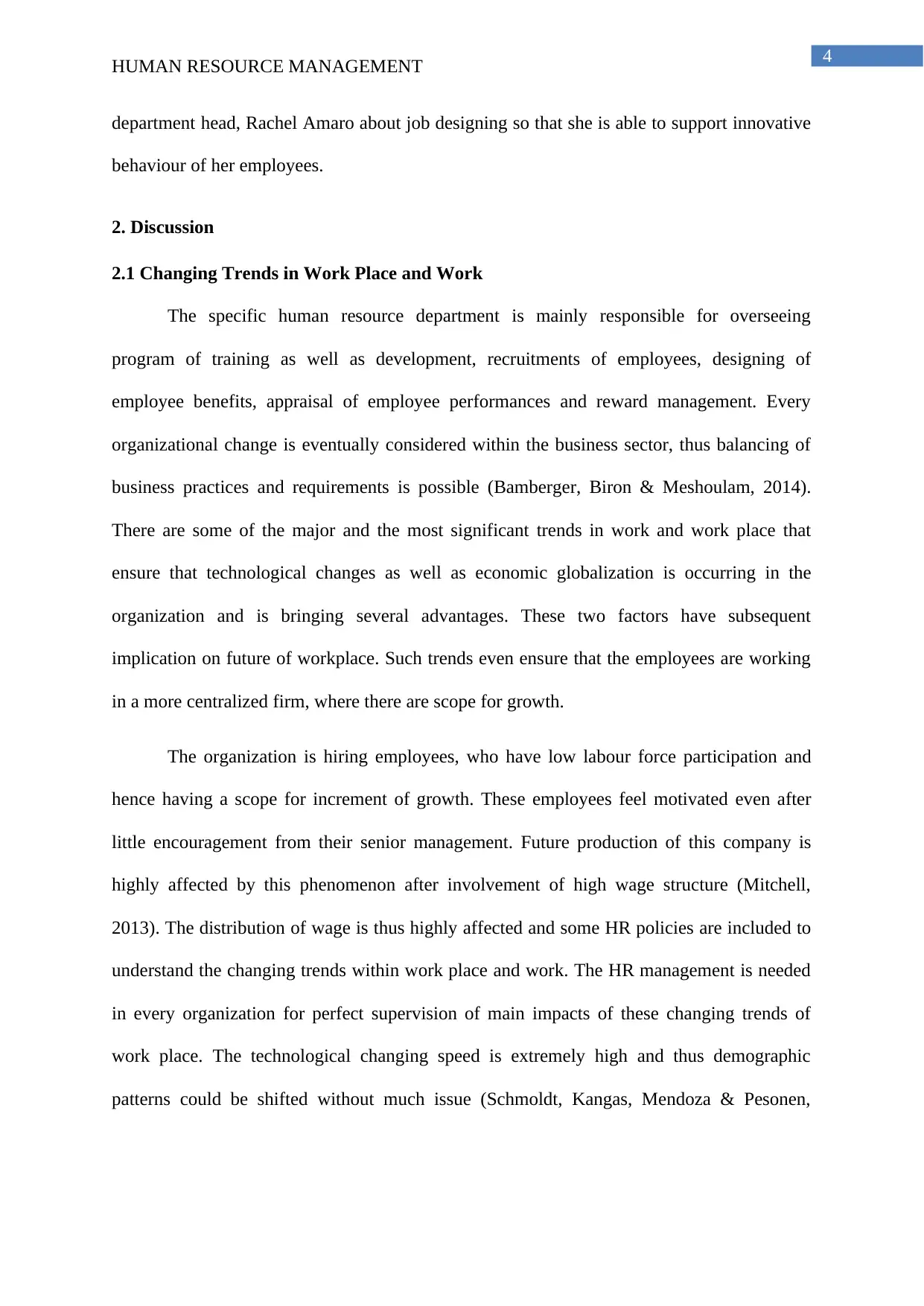
4
HUMAN RESOURCE MANAGEMENT
department head, Rachel Amaro about job designing so that she is able to support innovative
behaviour of her employees.
2. Discussion
2.1 Changing Trends in Work Place and Work
The specific human resource department is mainly responsible for overseeing
program of training as well as development, recruitments of employees, designing of
employee benefits, appraisal of employee performances and reward management. Every
organizational change is eventually considered within the business sector, thus balancing of
business practices and requirements is possible (Bamberger, Biron & Meshoulam, 2014).
There are some of the major and the most significant trends in work and work place that
ensure that technological changes as well as economic globalization is occurring in the
organization and is bringing several advantages. These two factors have subsequent
implication on future of workplace. Such trends even ensure that the employees are working
in a more centralized firm, where there are scope for growth.
The organization is hiring employees, who have low labour force participation and
hence having a scope for increment of growth. These employees feel motivated even after
little encouragement from their senior management. Future production of this company is
highly affected by this phenomenon after involvement of high wage structure (Mitchell,
2013). The distribution of wage is thus highly affected and some HR policies are included to
understand the changing trends within work place and work. The HR management is needed
in every organization for perfect supervision of main impacts of these changing trends of
work place. The technological changing speed is extremely high and thus demographic
patterns could be shifted without much issue (Schmoldt, Kangas, Mendoza & Pesonen,
HUMAN RESOURCE MANAGEMENT
department head, Rachel Amaro about job designing so that she is able to support innovative
behaviour of her employees.
2. Discussion
2.1 Changing Trends in Work Place and Work
The specific human resource department is mainly responsible for overseeing
program of training as well as development, recruitments of employees, designing of
employee benefits, appraisal of employee performances and reward management. Every
organizational change is eventually considered within the business sector, thus balancing of
business practices and requirements is possible (Bamberger, Biron & Meshoulam, 2014).
There are some of the major and the most significant trends in work and work place that
ensure that technological changes as well as economic globalization is occurring in the
organization and is bringing several advantages. These two factors have subsequent
implication on future of workplace. Such trends even ensure that the employees are working
in a more centralized firm, where there are scope for growth.
The organization is hiring employees, who have low labour force participation and
hence having a scope for increment of growth. These employees feel motivated even after
little encouragement from their senior management. Future production of this company is
highly affected by this phenomenon after involvement of high wage structure (Mitchell,
2013). The distribution of wage is thus highly affected and some HR policies are included to
understand the changing trends within work place and work. The HR management is needed
in every organization for perfect supervision of main impacts of these changing trends of
work place. The technological changing speed is extremely high and thus demographic
patterns could be shifted without much issue (Schmoldt, Kangas, Mendoza & Pesonen,
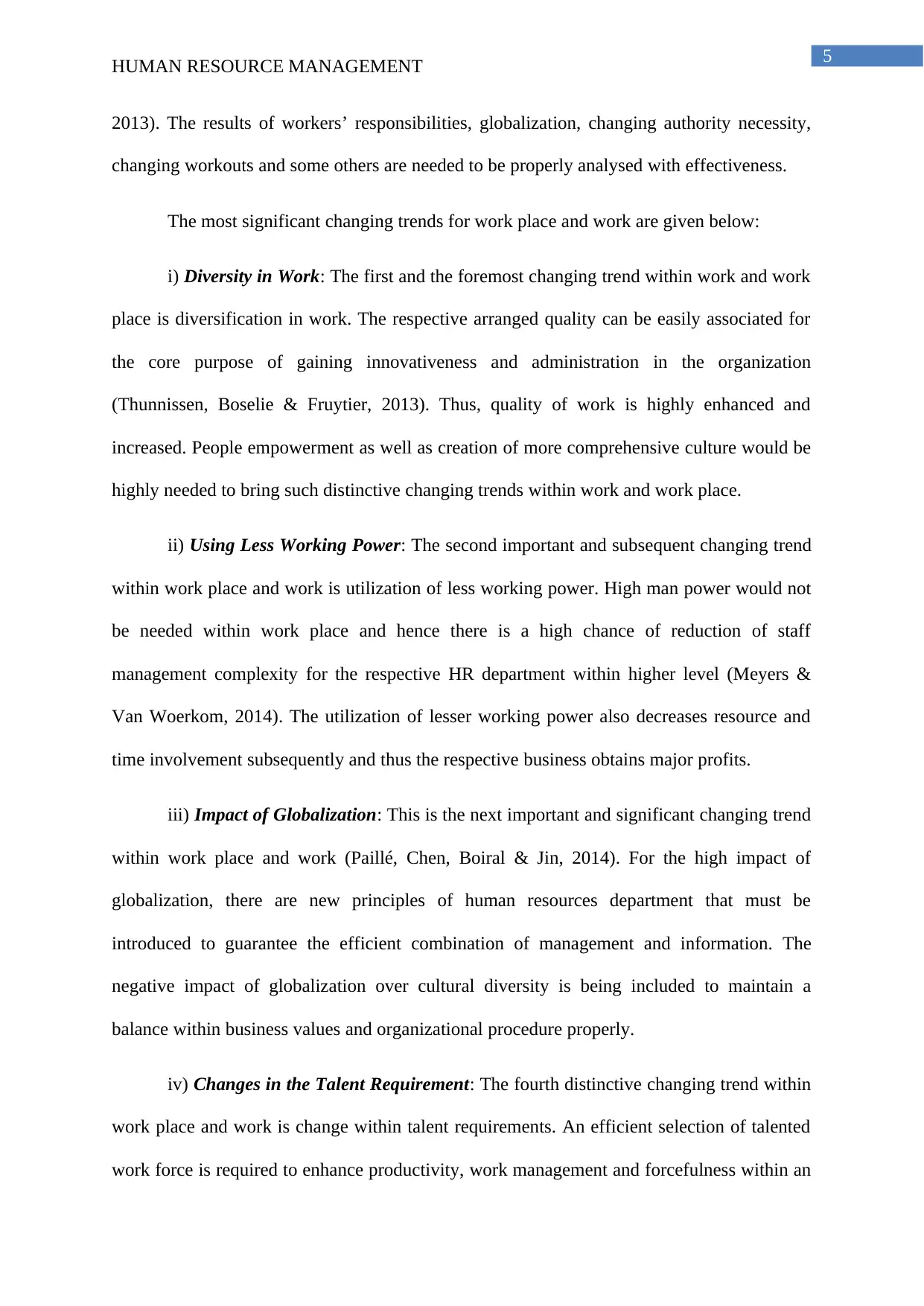
5
HUMAN RESOURCE MANAGEMENT
2013). The results of workers’ responsibilities, globalization, changing authority necessity,
changing workouts and some others are needed to be properly analysed with effectiveness.
The most significant changing trends for work place and work are given below:
i) Diversity in Work: The first and the foremost changing trend within work and work
place is diversification in work. The respective arranged quality can be easily associated for
the core purpose of gaining innovativeness and administration in the organization
(Thunnissen, Boselie & Fruytier, 2013). Thus, quality of work is highly enhanced and
increased. People empowerment as well as creation of more comprehensive culture would be
highly needed to bring such distinctive changing trends within work and work place.
ii) Using Less Working Power: The second important and subsequent changing trend
within work place and work is utilization of less working power. High man power would not
be needed within work place and hence there is a high chance of reduction of staff
management complexity for the respective HR department within higher level (Meyers &
Van Woerkom, 2014). The utilization of lesser working power also decreases resource and
time involvement subsequently and thus the respective business obtains major profits.
iii) Impact of Globalization: This is the next important and significant changing trend
within work place and work (Paillé, Chen, Boiral & Jin, 2014). For the high impact of
globalization, there are new principles of human resources department that must be
introduced to guarantee the efficient combination of management and information. The
negative impact of globalization over cultural diversity is being included to maintain a
balance within business values and organizational procedure properly.
iv) Changes in the Talent Requirement: The fourth distinctive changing trend within
work place and work is change within talent requirements. An efficient selection of talented
work force is required to enhance productivity, work management and forcefulness within an
HUMAN RESOURCE MANAGEMENT
2013). The results of workers’ responsibilities, globalization, changing authority necessity,
changing workouts and some others are needed to be properly analysed with effectiveness.
The most significant changing trends for work place and work are given below:
i) Diversity in Work: The first and the foremost changing trend within work and work
place is diversification in work. The respective arranged quality can be easily associated for
the core purpose of gaining innovativeness and administration in the organization
(Thunnissen, Boselie & Fruytier, 2013). Thus, quality of work is highly enhanced and
increased. People empowerment as well as creation of more comprehensive culture would be
highly needed to bring such distinctive changing trends within work and work place.
ii) Using Less Working Power: The second important and subsequent changing trend
within work place and work is utilization of less working power. High man power would not
be needed within work place and hence there is a high chance of reduction of staff
management complexity for the respective HR department within higher level (Meyers &
Van Woerkom, 2014). The utilization of lesser working power also decreases resource and
time involvement subsequently and thus the respective business obtains major profits.
iii) Impact of Globalization: This is the next important and significant changing trend
within work place and work (Paillé, Chen, Boiral & Jin, 2014). For the high impact of
globalization, there are new principles of human resources department that must be
introduced to guarantee the efficient combination of management and information. The
negative impact of globalization over cultural diversity is being included to maintain a
balance within business values and organizational procedure properly.
iv) Changes in the Talent Requirement: The fourth distinctive changing trend within
work place and work is change within talent requirements. An efficient selection of talented
work force is required to enhance productivity, work management and forcefulness within an
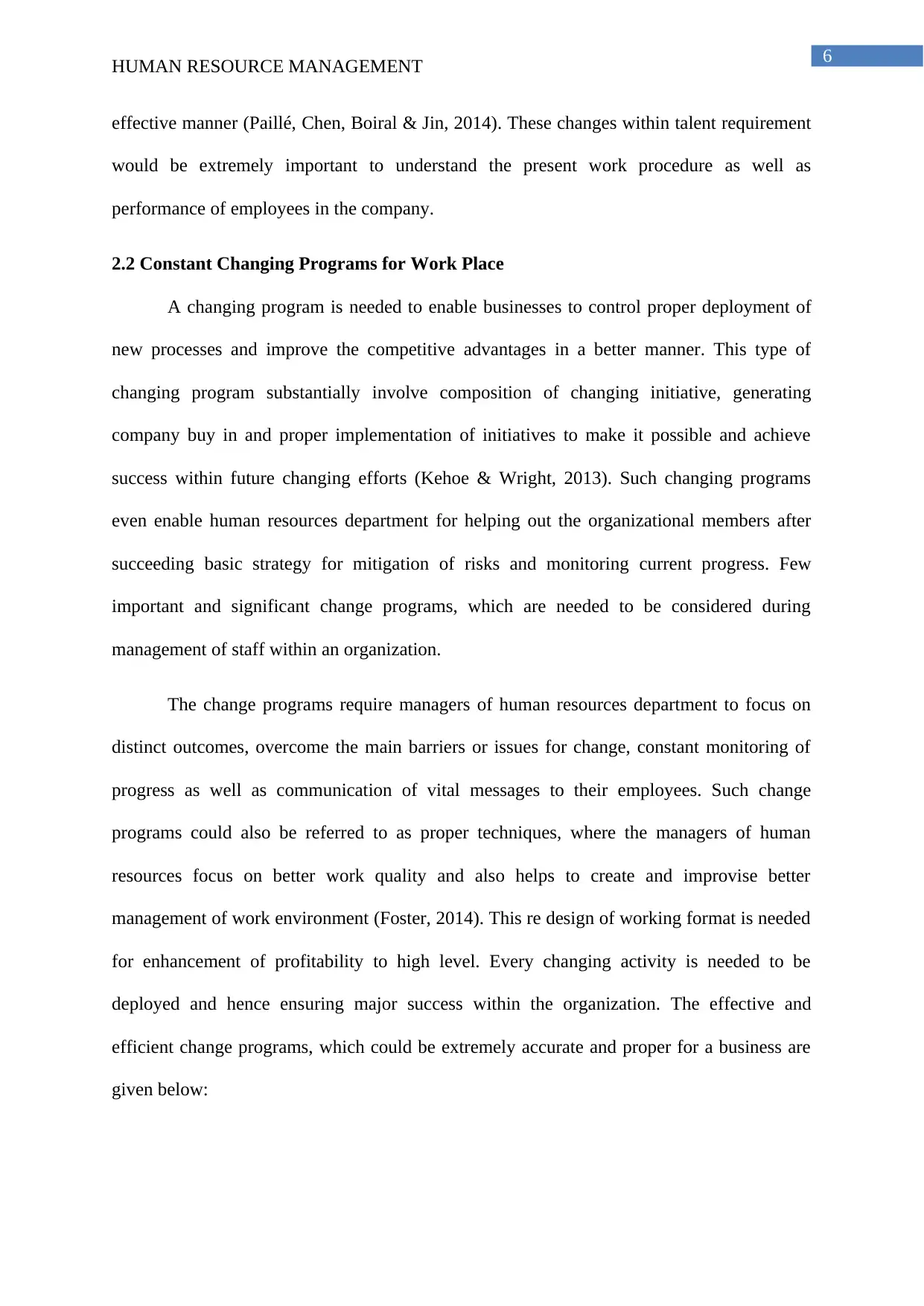
6
HUMAN RESOURCE MANAGEMENT
effective manner (Paillé, Chen, Boiral & Jin, 2014). These changes within talent requirement
would be extremely important to understand the present work procedure as well as
performance of employees in the company.
2.2 Constant Changing Programs for Work Place
A changing program is needed to enable businesses to control proper deployment of
new processes and improve the competitive advantages in a better manner. This type of
changing program substantially involve composition of changing initiative, generating
company buy in and proper implementation of initiatives to make it possible and achieve
success within future changing efforts (Kehoe & Wright, 2013). Such changing programs
even enable human resources department for helping out the organizational members after
succeeding basic strategy for mitigation of risks and monitoring current progress. Few
important and significant change programs, which are needed to be considered during
management of staff within an organization.
The change programs require managers of human resources department to focus on
distinct outcomes, overcome the main barriers or issues for change, constant monitoring of
progress as well as communication of vital messages to their employees. Such change
programs could also be referred to as proper techniques, where the managers of human
resources focus on better work quality and also helps to create and improvise better
management of work environment (Foster, 2014). This re design of working format is needed
for enhancement of profitability to high level. Every changing activity is needed to be
deployed and hence ensuring major success within the organization. The effective and
efficient change programs, which could be extremely accurate and proper for a business are
given below:
HUMAN RESOURCE MANAGEMENT
effective manner (Paillé, Chen, Boiral & Jin, 2014). These changes within talent requirement
would be extremely important to understand the present work procedure as well as
performance of employees in the company.
2.2 Constant Changing Programs for Work Place
A changing program is needed to enable businesses to control proper deployment of
new processes and improve the competitive advantages in a better manner. This type of
changing program substantially involve composition of changing initiative, generating
company buy in and proper implementation of initiatives to make it possible and achieve
success within future changing efforts (Kehoe & Wright, 2013). Such changing programs
even enable human resources department for helping out the organizational members after
succeeding basic strategy for mitigation of risks and monitoring current progress. Few
important and significant change programs, which are needed to be considered during
management of staff within an organization.
The change programs require managers of human resources department to focus on
distinct outcomes, overcome the main barriers or issues for change, constant monitoring of
progress as well as communication of vital messages to their employees. Such change
programs could also be referred to as proper techniques, where the managers of human
resources focus on better work quality and also helps to create and improvise better
management of work environment (Foster, 2014). This re design of working format is needed
for enhancement of profitability to high level. Every changing activity is needed to be
deployed and hence ensuring major success within the organization. The effective and
efficient change programs, which could be extremely accurate and proper for a business are
given below:
Secure Best Marks with AI Grader
Need help grading? Try our AI Grader for instant feedback on your assignments.
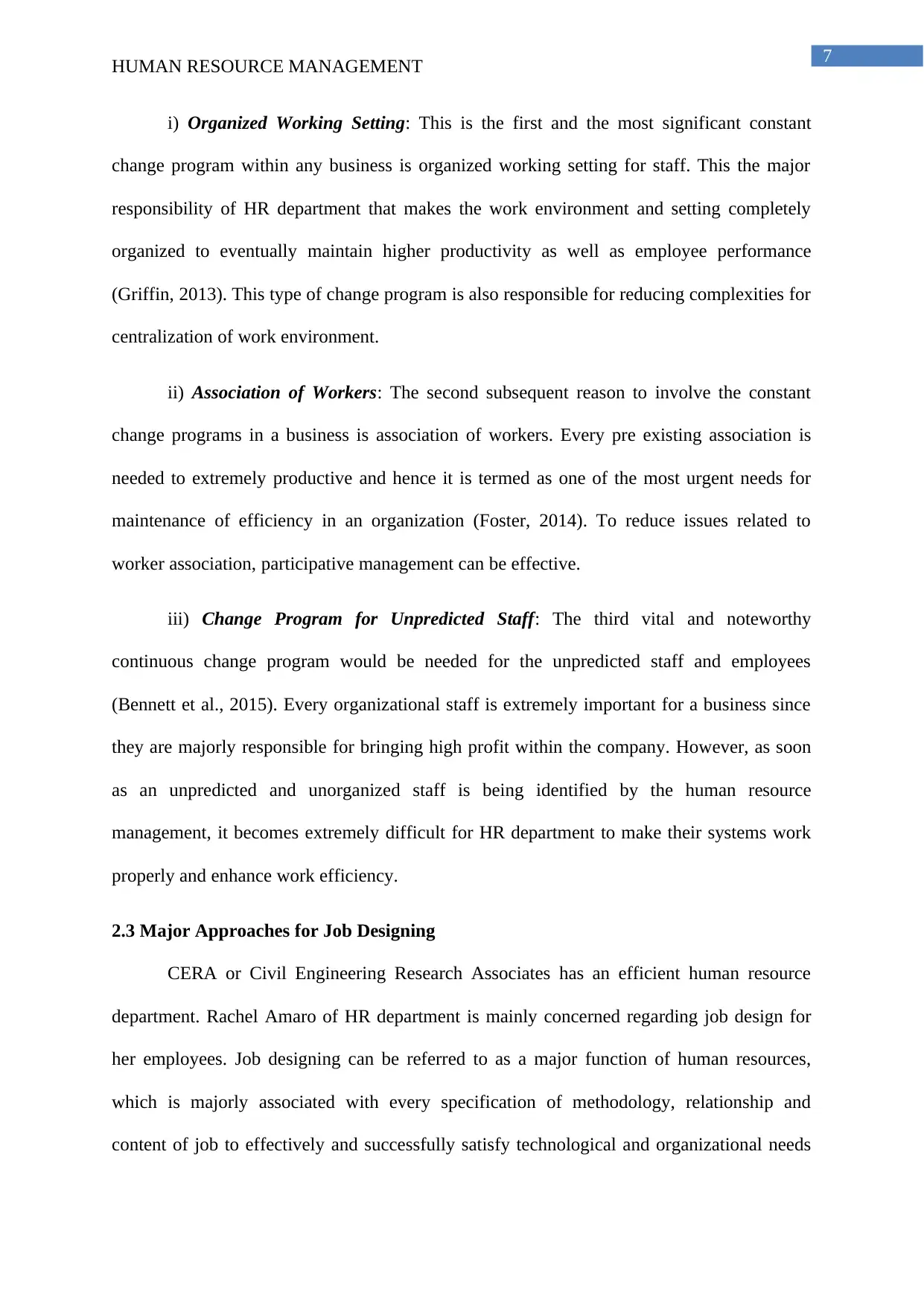
7
HUMAN RESOURCE MANAGEMENT
i) Organized Working Setting: This is the first and the most significant constant
change program within any business is organized working setting for staff. This the major
responsibility of HR department that makes the work environment and setting completely
organized to eventually maintain higher productivity as well as employee performance
(Griffin, 2013). This type of change program is also responsible for reducing complexities for
centralization of work environment.
ii) Association of Workers: The second subsequent reason to involve the constant
change programs in a business is association of workers. Every pre existing association is
needed to extremely productive and hence it is termed as one of the most urgent needs for
maintenance of efficiency in an organization (Foster, 2014). To reduce issues related to
worker association, participative management can be effective.
iii) Change Program for Unpredicted Staff: The third vital and noteworthy
continuous change program would be needed for the unpredicted staff and employees
(Bennett et al., 2015). Every organizational staff is extremely important for a business since
they are majorly responsible for bringing high profit within the company. However, as soon
as an unpredicted and unorganized staff is being identified by the human resource
management, it becomes extremely difficult for HR department to make their systems work
properly and enhance work efficiency.
2.3 Major Approaches for Job Designing
CERA or Civil Engineering Research Associates has an efficient human resource
department. Rachel Amaro of HR department is mainly concerned regarding job design for
her employees. Job designing can be referred to as a major function of human resources,
which is majorly associated with every specification of methodology, relationship and
content of job to effectively and successfully satisfy technological and organizational needs
HUMAN RESOURCE MANAGEMENT
i) Organized Working Setting: This is the first and the most significant constant
change program within any business is organized working setting for staff. This the major
responsibility of HR department that makes the work environment and setting completely
organized to eventually maintain higher productivity as well as employee performance
(Griffin, 2013). This type of change program is also responsible for reducing complexities for
centralization of work environment.
ii) Association of Workers: The second subsequent reason to involve the constant
change programs in a business is association of workers. Every pre existing association is
needed to extremely productive and hence it is termed as one of the most urgent needs for
maintenance of efficiency in an organization (Foster, 2014). To reduce issues related to
worker association, participative management can be effective.
iii) Change Program for Unpredicted Staff: The third vital and noteworthy
continuous change program would be needed for the unpredicted staff and employees
(Bennett et al., 2015). Every organizational staff is extremely important for a business since
they are majorly responsible for bringing high profit within the company. However, as soon
as an unpredicted and unorganized staff is being identified by the human resource
management, it becomes extremely difficult for HR department to make their systems work
properly and enhance work efficiency.
2.3 Major Approaches for Job Designing
CERA or Civil Engineering Research Associates has an efficient human resource
department. Rachel Amaro of HR department is mainly concerned regarding job design for
her employees. Job designing can be referred to as a major function of human resources,
which is majorly associated with every specification of methodology, relationship and
content of job to effectively and successfully satisfy technological and organizational needs

8
HUMAN RESOURCE MANAGEMENT
(Binder, 2016). Furthermore, social as well as personal requirements of employees are also
met by this distinctive procedure. Job satisfaction could be improvised for all employees and
thus business throughput is being improved mainly.
The work quality is also improved and thus issues related to employee performance
are reduced effectively. The most significant job dimensions to design any specific job
involves task identity, autonomy, feedback, significance of tasks and variety of skills. An
intrinsic employee motivation is also enhanced and thus performances and quality of work
are enhanced (Shaw, Park & Kim, 2013). Numerous vital techniques towards job design are
present such as job enrichment, scientific management, job rotation and job enlargement. All
of such techniques for job designing are extremely helpful for better maintenance of an
effective involvement as well as participation of employee.
Reforming of work eventually refers to better work place rotation and changes made,
which are much relevant to staff as well as management of employee to encourage increased
participation of work force (Birasnav, 2014). Rachel Amaro of CERA has four distinctive
approaches and options of job design and these four approaches are given below:
i) Motivational Job Designing Approach: This is the first as well as the most
significant or vital approach of job design, which can be used by Rachel. Few major and
significant features are present in the business, which are eventually enhanced by the
motivational job designing approach (Strohmeier, 2013). These types of features eventually
include extrinsic feedback of job, social interactions, and intrinsic feedback of job, task
identity, significance of task, autonomy, skilled level needs and growth of the skills. The
respective psychological aspects or features over employee motivation must be understood in
a better manner by Rachel in CERA so that she can easily and promptly obtain subsequent
and considerable evidence for job design to have influences on job motivation, performance
HUMAN RESOURCE MANAGEMENT
(Binder, 2016). Furthermore, social as well as personal requirements of employees are also
met by this distinctive procedure. Job satisfaction could be improvised for all employees and
thus business throughput is being improved mainly.
The work quality is also improved and thus issues related to employee performance
are reduced effectively. The most significant job dimensions to design any specific job
involves task identity, autonomy, feedback, significance of tasks and variety of skills. An
intrinsic employee motivation is also enhanced and thus performances and quality of work
are enhanced (Shaw, Park & Kim, 2013). Numerous vital techniques towards job design are
present such as job enrichment, scientific management, job rotation and job enlargement. All
of such techniques for job designing are extremely helpful for better maintenance of an
effective involvement as well as participation of employee.
Reforming of work eventually refers to better work place rotation and changes made,
which are much relevant to staff as well as management of employee to encourage increased
participation of work force (Birasnav, 2014). Rachel Amaro of CERA has four distinctive
approaches and options of job design and these four approaches are given below:
i) Motivational Job Designing Approach: This is the first as well as the most
significant or vital approach of job design, which can be used by Rachel. Few major and
significant features are present in the business, which are eventually enhanced by the
motivational job designing approach (Strohmeier, 2013). These types of features eventually
include extrinsic feedback of job, social interactions, and intrinsic feedback of job, task
identity, significance of task, autonomy, skilled level needs and growth of the skills. The
respective psychological aspects or features over employee motivation must be understood in
a better manner by Rachel in CERA so that she can easily and promptly obtain subsequent
and considerable evidence for job design to have influences on job motivation, performance
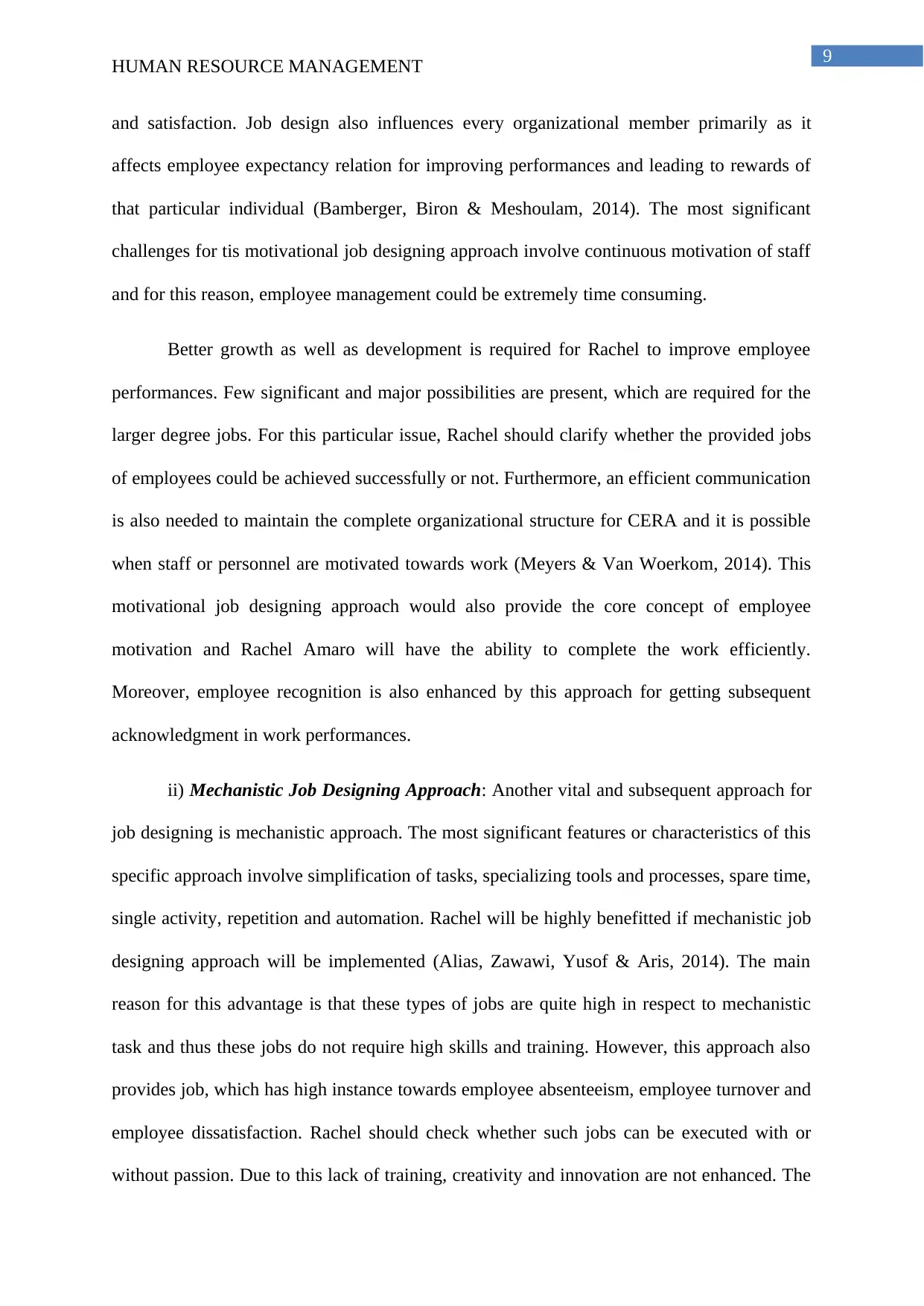
9
HUMAN RESOURCE MANAGEMENT
and satisfaction. Job design also influences every organizational member primarily as it
affects employee expectancy relation for improving performances and leading to rewards of
that particular individual (Bamberger, Biron & Meshoulam, 2014). The most significant
challenges for tis motivational job designing approach involve continuous motivation of staff
and for this reason, employee management could be extremely time consuming.
Better growth as well as development is required for Rachel to improve employee
performances. Few significant and major possibilities are present, which are required for the
larger degree jobs. For this particular issue, Rachel should clarify whether the provided jobs
of employees could be achieved successfully or not. Furthermore, an efficient communication
is also needed to maintain the complete organizational structure for CERA and it is possible
when staff or personnel are motivated towards work (Meyers & Van Woerkom, 2014). This
motivational job designing approach would also provide the core concept of employee
motivation and Rachel Amaro will have the ability to complete the work efficiently.
Moreover, employee recognition is also enhanced by this approach for getting subsequent
acknowledgment in work performances.
ii) Mechanistic Job Designing Approach: Another vital and subsequent approach for
job designing is mechanistic approach. The most significant features or characteristics of this
specific approach involve simplification of tasks, specializing tools and processes, spare time,
single activity, repetition and automation. Rachel will be highly benefitted if mechanistic job
designing approach will be implemented (Alias, Zawawi, Yusof & Aris, 2014). The main
reason for this advantage is that these types of jobs are quite high in respect to mechanistic
task and thus these jobs do not require high skills and training. However, this approach also
provides job, which has high instance towards employee absenteeism, employee turnover and
employee dissatisfaction. Rachel should check whether such jobs can be executed with or
without passion. Due to this lack of training, creativity and innovation are not enhanced. The
HUMAN RESOURCE MANAGEMENT
and satisfaction. Job design also influences every organizational member primarily as it
affects employee expectancy relation for improving performances and leading to rewards of
that particular individual (Bamberger, Biron & Meshoulam, 2014). The most significant
challenges for tis motivational job designing approach involve continuous motivation of staff
and for this reason, employee management could be extremely time consuming.
Better growth as well as development is required for Rachel to improve employee
performances. Few significant and major possibilities are present, which are required for the
larger degree jobs. For this particular issue, Rachel should clarify whether the provided jobs
of employees could be achieved successfully or not. Furthermore, an efficient communication
is also needed to maintain the complete organizational structure for CERA and it is possible
when staff or personnel are motivated towards work (Meyers & Van Woerkom, 2014). This
motivational job designing approach would also provide the core concept of employee
motivation and Rachel Amaro will have the ability to complete the work efficiently.
Moreover, employee recognition is also enhanced by this approach for getting subsequent
acknowledgment in work performances.
ii) Mechanistic Job Designing Approach: Another vital and subsequent approach for
job designing is mechanistic approach. The most significant features or characteristics of this
specific approach involve simplification of tasks, specializing tools and processes, spare time,
single activity, repetition and automation. Rachel will be highly benefitted if mechanistic job
designing approach will be implemented (Alias, Zawawi, Yusof & Aris, 2014). The main
reason for this advantage is that these types of jobs are quite high in respect to mechanistic
task and thus these jobs do not require high skills and training. However, this approach also
provides job, which has high instance towards employee absenteeism, employee turnover and
employee dissatisfaction. Rachel should check whether such jobs can be executed with or
without passion. Due to this lack of training, creativity and innovation are not enhanced. The
Paraphrase This Document
Need a fresh take? Get an instant paraphrase of this document with our AI Paraphraser
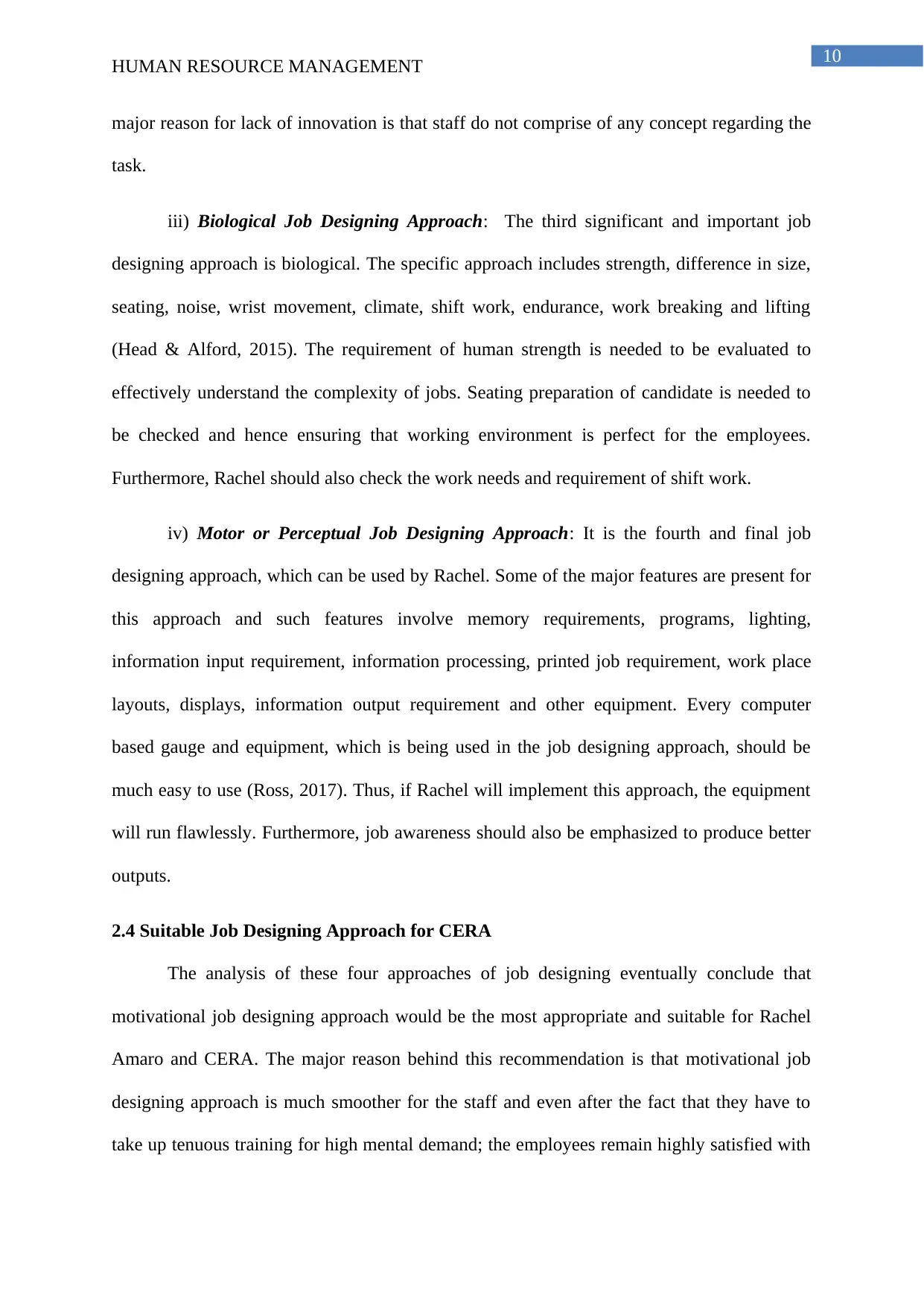
10
HUMAN RESOURCE MANAGEMENT
major reason for lack of innovation is that staff do not comprise of any concept regarding the
task.
iii) Biological Job Designing Approach: The third significant and important job
designing approach is biological. The specific approach includes strength, difference in size,
seating, noise, wrist movement, climate, shift work, endurance, work breaking and lifting
(Head & Alford, 2015). The requirement of human strength is needed to be evaluated to
effectively understand the complexity of jobs. Seating preparation of candidate is needed to
be checked and hence ensuring that working environment is perfect for the employees.
Furthermore, Rachel should also check the work needs and requirement of shift work.
iv) Motor or Perceptual Job Designing Approach: It is the fourth and final job
designing approach, which can be used by Rachel. Some of the major features are present for
this approach and such features involve memory requirements, programs, lighting,
information input requirement, information processing, printed job requirement, work place
layouts, displays, information output requirement and other equipment. Every computer
based gauge and equipment, which is being used in the job designing approach, should be
much easy to use (Ross, 2017). Thus, if Rachel will implement this approach, the equipment
will run flawlessly. Furthermore, job awareness should also be emphasized to produce better
outputs.
2.4 Suitable Job Designing Approach for CERA
The analysis of these four approaches of job designing eventually conclude that
motivational job designing approach would be the most appropriate and suitable for Rachel
Amaro and CERA. The major reason behind this recommendation is that motivational job
designing approach is much smoother for the staff and even after the fact that they have to
take up tenuous training for high mental demand; the employees remain highly satisfied with
HUMAN RESOURCE MANAGEMENT
major reason for lack of innovation is that staff do not comprise of any concept regarding the
task.
iii) Biological Job Designing Approach: The third significant and important job
designing approach is biological. The specific approach includes strength, difference in size,
seating, noise, wrist movement, climate, shift work, endurance, work breaking and lifting
(Head & Alford, 2015). The requirement of human strength is needed to be evaluated to
effectively understand the complexity of jobs. Seating preparation of candidate is needed to
be checked and hence ensuring that working environment is perfect for the employees.
Furthermore, Rachel should also check the work needs and requirement of shift work.
iv) Motor or Perceptual Job Designing Approach: It is the fourth and final job
designing approach, which can be used by Rachel. Some of the major features are present for
this approach and such features involve memory requirements, programs, lighting,
information input requirement, information processing, printed job requirement, work place
layouts, displays, information output requirement and other equipment. Every computer
based gauge and equipment, which is being used in the job designing approach, should be
much easy to use (Ross, 2017). Thus, if Rachel will implement this approach, the equipment
will run flawlessly. Furthermore, job awareness should also be emphasized to produce better
outputs.
2.4 Suitable Job Designing Approach for CERA
The analysis of these four approaches of job designing eventually conclude that
motivational job designing approach would be the most appropriate and suitable for Rachel
Amaro and CERA. The major reason behind this recommendation is that motivational job
designing approach is much smoother for the staff and even after the fact that they have to
take up tenuous training for high mental demand; the employees remain highly satisfied with
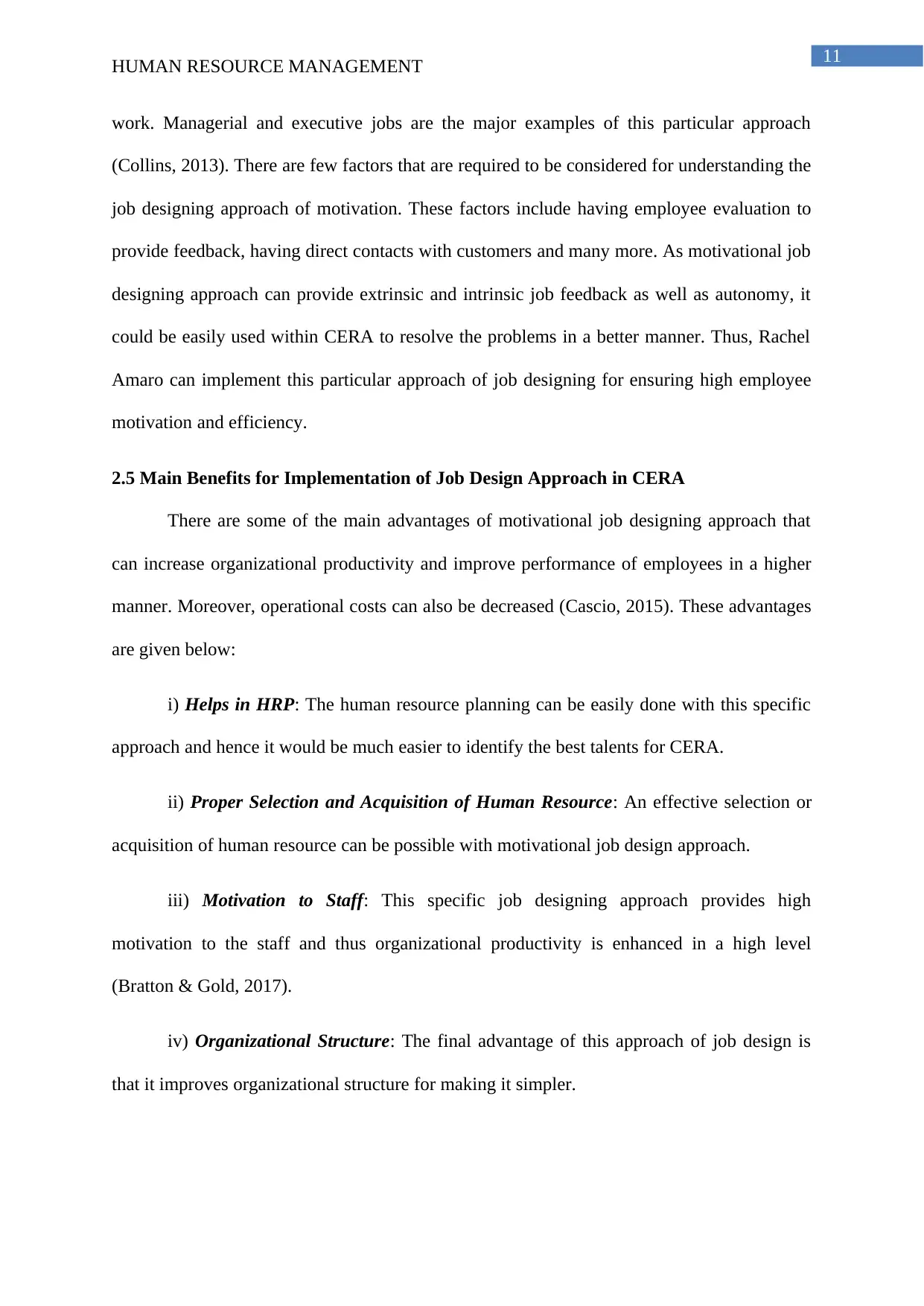
11
HUMAN RESOURCE MANAGEMENT
work. Managerial and executive jobs are the major examples of this particular approach
(Collins, 2013). There are few factors that are required to be considered for understanding the
job designing approach of motivation. These factors include having employee evaluation to
provide feedback, having direct contacts with customers and many more. As motivational job
designing approach can provide extrinsic and intrinsic job feedback as well as autonomy, it
could be easily used within CERA to resolve the problems in a better manner. Thus, Rachel
Amaro can implement this particular approach of job designing for ensuring high employee
motivation and efficiency.
2.5 Main Benefits for Implementation of Job Design Approach in CERA
There are some of the main advantages of motivational job designing approach that
can increase organizational productivity and improve performance of employees in a higher
manner. Moreover, operational costs can also be decreased (Cascio, 2015). These advantages
are given below:
i) Helps in HRP: The human resource planning can be easily done with this specific
approach and hence it would be much easier to identify the best talents for CERA.
ii) Proper Selection and Acquisition of Human Resource: An effective selection or
acquisition of human resource can be possible with motivational job design approach.
iii) Motivation to Staff: This specific job designing approach provides high
motivation to the staff and thus organizational productivity is enhanced in a high level
(Bratton & Gold, 2017).
iv) Organizational Structure: The final advantage of this approach of job design is
that it improves organizational structure for making it simpler.
HUMAN RESOURCE MANAGEMENT
work. Managerial and executive jobs are the major examples of this particular approach
(Collins, 2013). There are few factors that are required to be considered for understanding the
job designing approach of motivation. These factors include having employee evaluation to
provide feedback, having direct contacts with customers and many more. As motivational job
designing approach can provide extrinsic and intrinsic job feedback as well as autonomy, it
could be easily used within CERA to resolve the problems in a better manner. Thus, Rachel
Amaro can implement this particular approach of job designing for ensuring high employee
motivation and efficiency.
2.5 Main Benefits for Implementation of Job Design Approach in CERA
There are some of the main advantages of motivational job designing approach that
can increase organizational productivity and improve performance of employees in a higher
manner. Moreover, operational costs can also be decreased (Cascio, 2015). These advantages
are given below:
i) Helps in HRP: The human resource planning can be easily done with this specific
approach and hence it would be much easier to identify the best talents for CERA.
ii) Proper Selection and Acquisition of Human Resource: An effective selection or
acquisition of human resource can be possible with motivational job design approach.
iii) Motivation to Staff: This specific job designing approach provides high
motivation to the staff and thus organizational productivity is enhanced in a high level
(Bratton & Gold, 2017).
iv) Organizational Structure: The final advantage of this approach of job design is
that it improves organizational structure for making it simpler.
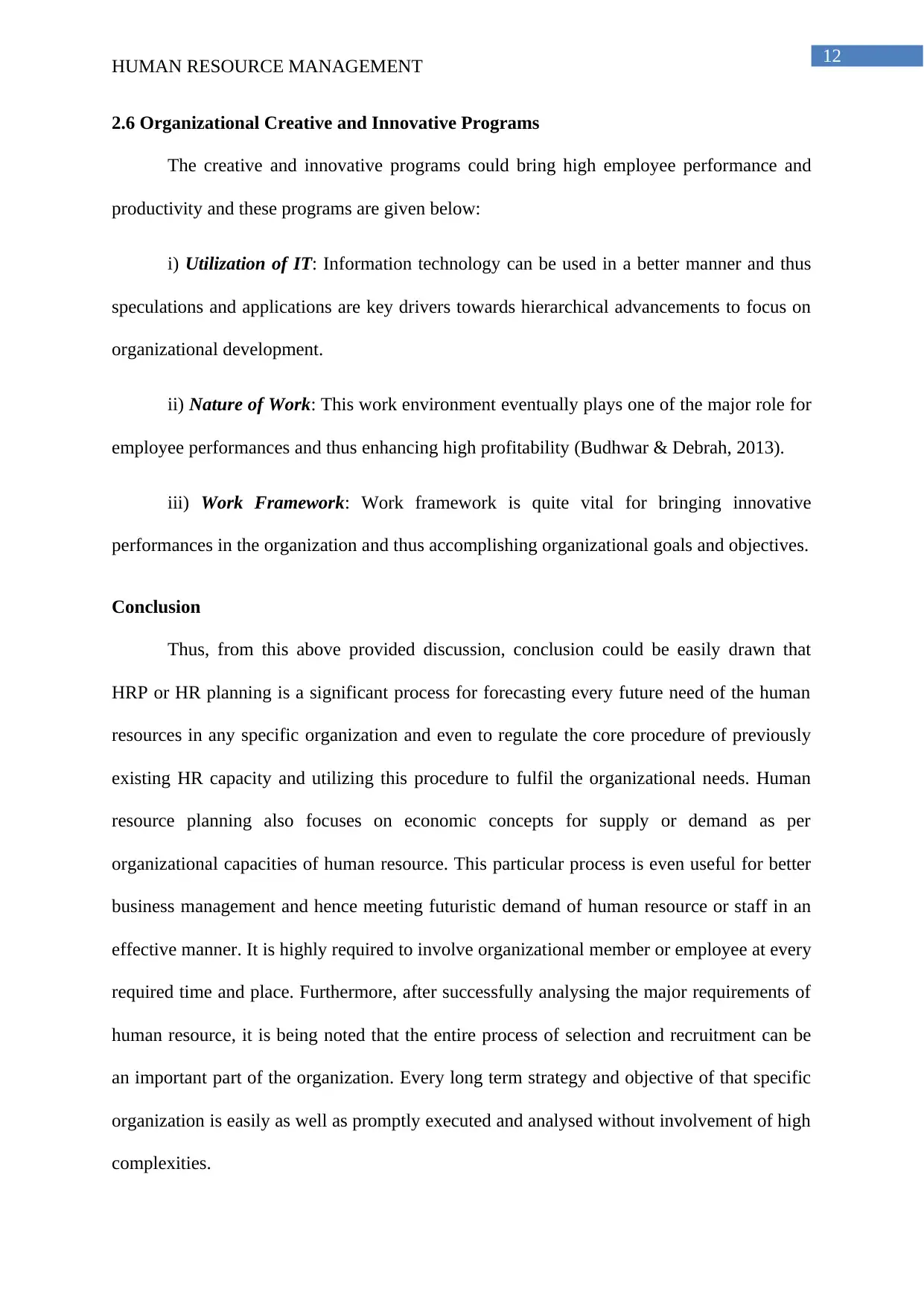
12
HUMAN RESOURCE MANAGEMENT
2.6 Organizational Creative and Innovative Programs
The creative and innovative programs could bring high employee performance and
productivity and these programs are given below:
i) Utilization of IT: Information technology can be used in a better manner and thus
speculations and applications are key drivers towards hierarchical advancements to focus on
organizational development.
ii) Nature of Work: This work environment eventually plays one of the major role for
employee performances and thus enhancing high profitability (Budhwar & Debrah, 2013).
iii) Work Framework: Work framework is quite vital for bringing innovative
performances in the organization and thus accomplishing organizational goals and objectives.
Conclusion
Thus, from this above provided discussion, conclusion could be easily drawn that
HRP or HR planning is a significant process for forecasting every future need of the human
resources in any specific organization and even to regulate the core procedure of previously
existing HR capacity and utilizing this procedure to fulfil the organizational needs. Human
resource planning also focuses on economic concepts for supply or demand as per
organizational capacities of human resource. This particular process is even useful for better
business management and hence meeting futuristic demand of human resource or staff in an
effective manner. It is highly required to involve organizational member or employee at every
required time and place. Furthermore, after successfully analysing the major requirements of
human resource, it is being noted that the entire process of selection and recruitment can be
an important part of the organization. Every long term strategy and objective of that specific
organization is easily as well as promptly executed and analysed without involvement of high
complexities.
HUMAN RESOURCE MANAGEMENT
2.6 Organizational Creative and Innovative Programs
The creative and innovative programs could bring high employee performance and
productivity and these programs are given below:
i) Utilization of IT: Information technology can be used in a better manner and thus
speculations and applications are key drivers towards hierarchical advancements to focus on
organizational development.
ii) Nature of Work: This work environment eventually plays one of the major role for
employee performances and thus enhancing high profitability (Budhwar & Debrah, 2013).
iii) Work Framework: Work framework is quite vital for bringing innovative
performances in the organization and thus accomplishing organizational goals and objectives.
Conclusion
Thus, from this above provided discussion, conclusion could be easily drawn that
HRP or HR planning is a significant process for forecasting every future need of the human
resources in any specific organization and even to regulate the core procedure of previously
existing HR capacity and utilizing this procedure to fulfil the organizational needs. Human
resource planning also focuses on economic concepts for supply or demand as per
organizational capacities of human resource. This particular process is even useful for better
business management and hence meeting futuristic demand of human resource or staff in an
effective manner. It is highly required to involve organizational member or employee at every
required time and place. Furthermore, after successfully analysing the major requirements of
human resource, it is being noted that the entire process of selection and recruitment can be
an important part of the organization. Every long term strategy and objective of that specific
organization is easily as well as promptly executed and analysed without involvement of high
complexities.
Secure Best Marks with AI Grader
Need help grading? Try our AI Grader for instant feedback on your assignments.
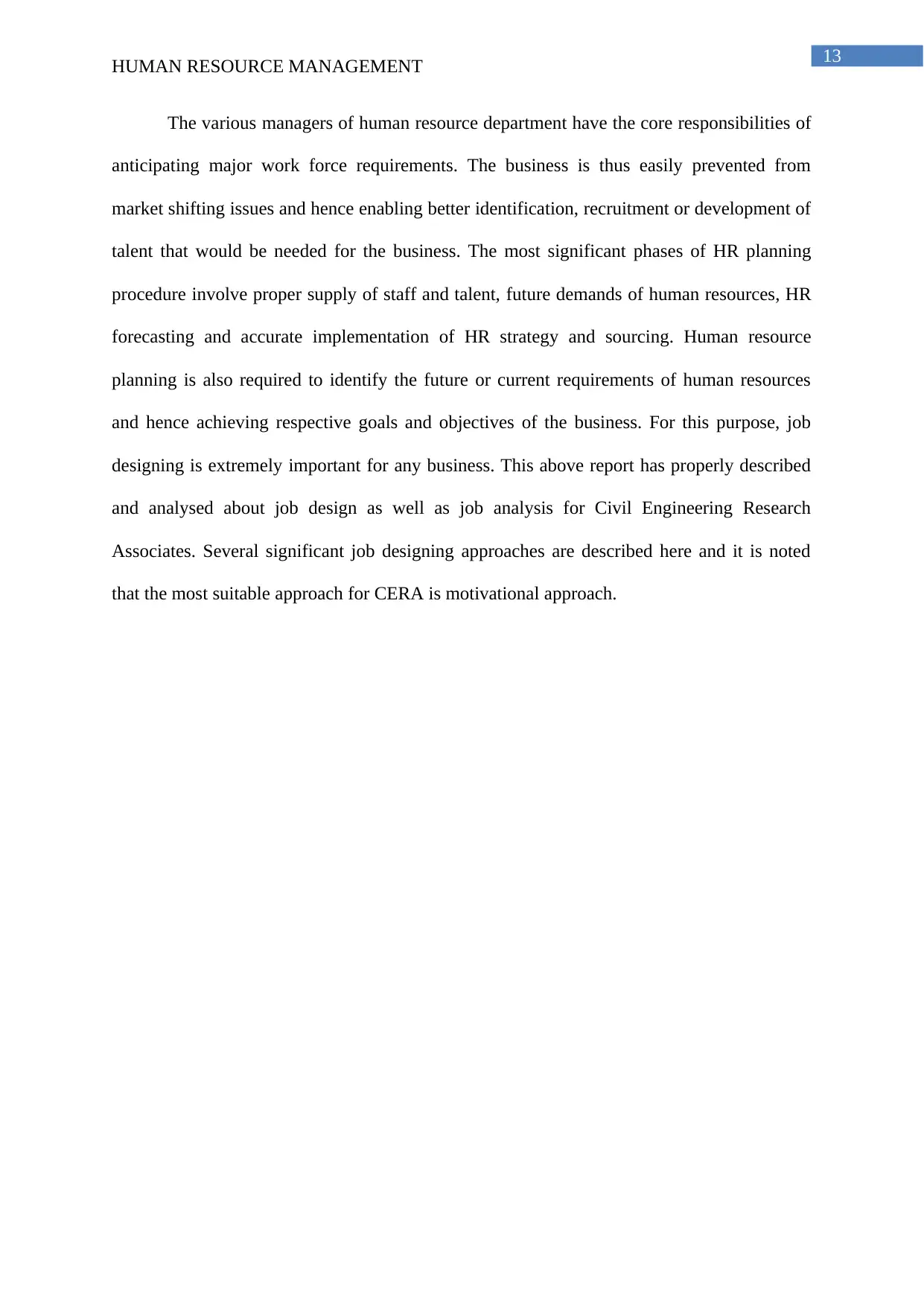
13
HUMAN RESOURCE MANAGEMENT
The various managers of human resource department have the core responsibilities of
anticipating major work force requirements. The business is thus easily prevented from
market shifting issues and hence enabling better identification, recruitment or development of
talent that would be needed for the business. The most significant phases of HR planning
procedure involve proper supply of staff and talent, future demands of human resources, HR
forecasting and accurate implementation of HR strategy and sourcing. Human resource
planning is also required to identify the future or current requirements of human resources
and hence achieving respective goals and objectives of the business. For this purpose, job
designing is extremely important for any business. This above report has properly described
and analysed about job design as well as job analysis for Civil Engineering Research
Associates. Several significant job designing approaches are described here and it is noted
that the most suitable approach for CERA is motivational approach.
HUMAN RESOURCE MANAGEMENT
The various managers of human resource department have the core responsibilities of
anticipating major work force requirements. The business is thus easily prevented from
market shifting issues and hence enabling better identification, recruitment or development of
talent that would be needed for the business. The most significant phases of HR planning
procedure involve proper supply of staff and talent, future demands of human resources, HR
forecasting and accurate implementation of HR strategy and sourcing. Human resource
planning is also required to identify the future or current requirements of human resources
and hence achieving respective goals and objectives of the business. For this purpose, job
designing is extremely important for any business. This above report has properly described
and analysed about job design as well as job analysis for Civil Engineering Research
Associates. Several significant job designing approaches are described here and it is noted
that the most suitable approach for CERA is motivational approach.

14
HUMAN RESOURCE MANAGEMENT
References
Al Ariss, A., Cascio, W. F., & Paauwe, J. (2014). Talent management: Current theories and
future research directions. Journal of World Business, 49(2), 173-179.
Alias, Z., Zawawi, E. M. A., Yusof, K., & Aris, N. M. (2014). Determining critical success
factors of project management practice: A conceptual framework. Procedia-Social
and Behavioral Sciences, 153, 61-69.
Bamberger, P. A., Biron, M., & Meshoulam, I. (2014). Human resource strategy:
Formulation, implementation, and impact. Routledge.
Bennett, E. M., Cramer, W., Begossi, A., Cundill, G., Díaz, S., Egoh, B. N., ... & Lebel, L.
(2015). Linking biodiversity, ecosystem services, and human well-being: three
challenges for designing research for sustainability. Current opinion in environmental
sustainability, 14, 76-85.
Binder, J. (2016). Global project management: communication, collaboration and
management across borders. Routledge.
Birasnav, M. (2014). Knowledge management and organizational performance in the service
industry: The role of transformational leadership beyond the effects of transactional
leadership. Journal of Business Research, 67(8), 1622-1629.
Bratton, J., & Gold, J. (2017). Human resource management: theory and practice. Palgrave.
Budhwar, P. S., & Debrah, Y. A. (Eds.). (2013). Human resource management in developing
countries. Routledge.
Cascio, W. F. (2015). Managing human resources. McGraw-Hill.
HUMAN RESOURCE MANAGEMENT
References
Al Ariss, A., Cascio, W. F., & Paauwe, J. (2014). Talent management: Current theories and
future research directions. Journal of World Business, 49(2), 173-179.
Alias, Z., Zawawi, E. M. A., Yusof, K., & Aris, N. M. (2014). Determining critical success
factors of project management practice: A conceptual framework. Procedia-Social
and Behavioral Sciences, 153, 61-69.
Bamberger, P. A., Biron, M., & Meshoulam, I. (2014). Human resource strategy:
Formulation, implementation, and impact. Routledge.
Bennett, E. M., Cramer, W., Begossi, A., Cundill, G., Díaz, S., Egoh, B. N., ... & Lebel, L.
(2015). Linking biodiversity, ecosystem services, and human well-being: three
challenges for designing research for sustainability. Current opinion in environmental
sustainability, 14, 76-85.
Binder, J. (2016). Global project management: communication, collaboration and
management across borders. Routledge.
Birasnav, M. (2014). Knowledge management and organizational performance in the service
industry: The role of transformational leadership beyond the effects of transactional
leadership. Journal of Business Research, 67(8), 1622-1629.
Bratton, J., & Gold, J. (2017). Human resource management: theory and practice. Palgrave.
Budhwar, P. S., & Debrah, Y. A. (Eds.). (2013). Human resource management in developing
countries. Routledge.
Cascio, W. F. (2015). Managing human resources. McGraw-Hill.
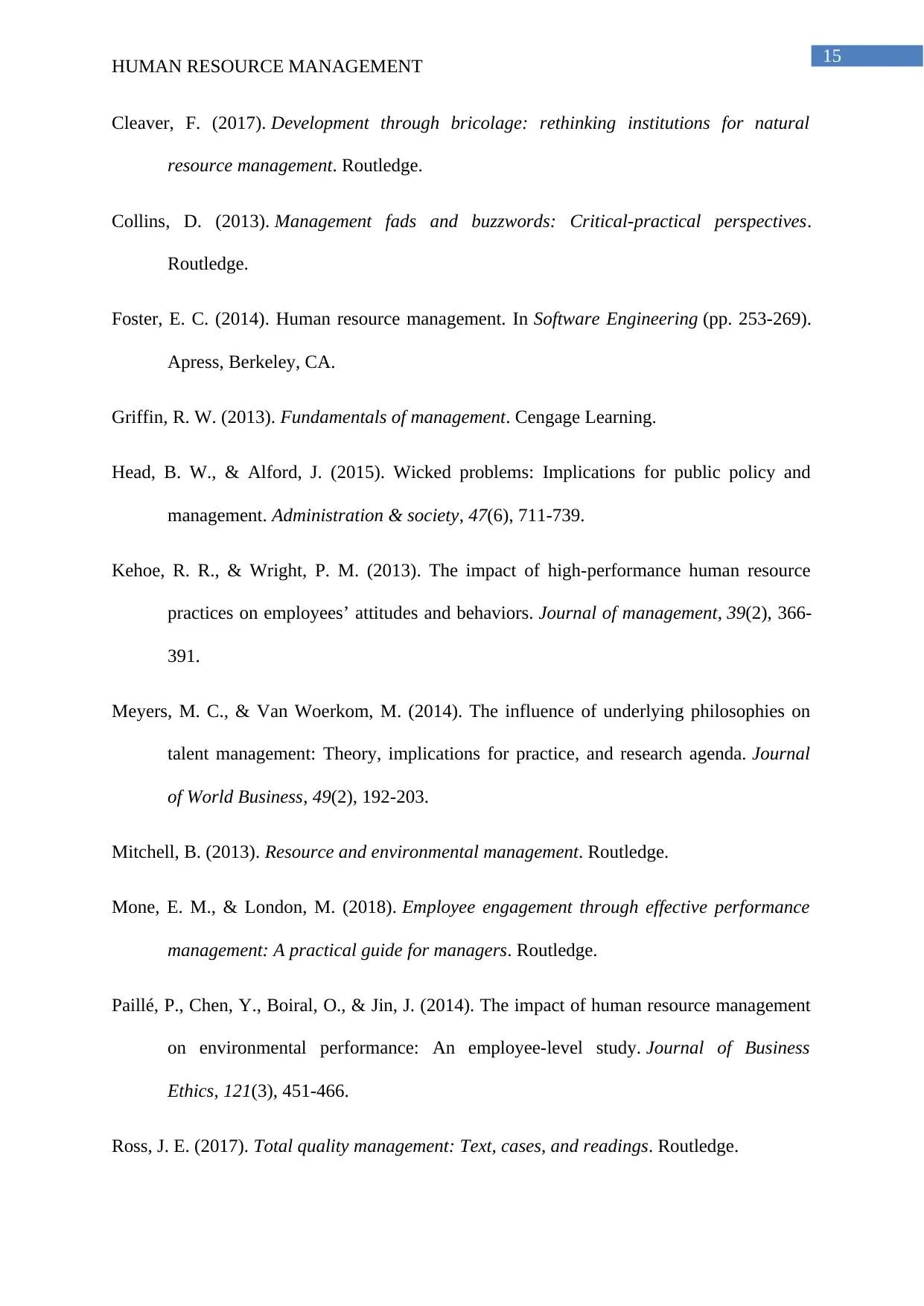
15
HUMAN RESOURCE MANAGEMENT
Cleaver, F. (2017). Development through bricolage: rethinking institutions for natural
resource management. Routledge.
Collins, D. (2013). Management fads and buzzwords: Critical-practical perspectives.
Routledge.
Foster, E. C. (2014). Human resource management. In Software Engineering (pp. 253-269).
Apress, Berkeley, CA.
Griffin, R. W. (2013). Fundamentals of management. Cengage Learning.
Head, B. W., & Alford, J. (2015). Wicked problems: Implications for public policy and
management. Administration & society, 47(6), 711-739.
Kehoe, R. R., & Wright, P. M. (2013). The impact of high-performance human resource
practices on employees’ attitudes and behaviors. Journal of management, 39(2), 366-
391.
Meyers, M. C., & Van Woerkom, M. (2014). The influence of underlying philosophies on
talent management: Theory, implications for practice, and research agenda. Journal
of World Business, 49(2), 192-203.
Mitchell, B. (2013). Resource and environmental management. Routledge.
Mone, E. M., & London, M. (2018). Employee engagement through effective performance
management: A practical guide for managers. Routledge.
Paillé, P., Chen, Y., Boiral, O., & Jin, J. (2014). The impact of human resource management
on environmental performance: An employee-level study. Journal of Business
Ethics, 121(3), 451-466.
Ross, J. E. (2017). Total quality management: Text, cases, and readings. Routledge.
HUMAN RESOURCE MANAGEMENT
Cleaver, F. (2017). Development through bricolage: rethinking institutions for natural
resource management. Routledge.
Collins, D. (2013). Management fads and buzzwords: Critical-practical perspectives.
Routledge.
Foster, E. C. (2014). Human resource management. In Software Engineering (pp. 253-269).
Apress, Berkeley, CA.
Griffin, R. W. (2013). Fundamentals of management. Cengage Learning.
Head, B. W., & Alford, J. (2015). Wicked problems: Implications for public policy and
management. Administration & society, 47(6), 711-739.
Kehoe, R. R., & Wright, P. M. (2013). The impact of high-performance human resource
practices on employees’ attitudes and behaviors. Journal of management, 39(2), 366-
391.
Meyers, M. C., & Van Woerkom, M. (2014). The influence of underlying philosophies on
talent management: Theory, implications for practice, and research agenda. Journal
of World Business, 49(2), 192-203.
Mitchell, B. (2013). Resource and environmental management. Routledge.
Mone, E. M., & London, M. (2018). Employee engagement through effective performance
management: A practical guide for managers. Routledge.
Paillé, P., Chen, Y., Boiral, O., & Jin, J. (2014). The impact of human resource management
on environmental performance: An employee-level study. Journal of Business
Ethics, 121(3), 451-466.
Ross, J. E. (2017). Total quality management: Text, cases, and readings. Routledge.
Paraphrase This Document
Need a fresh take? Get an instant paraphrase of this document with our AI Paraphraser

16
HUMAN RESOURCE MANAGEMENT
Schmoldt, D., Kangas, J., Mendoza, G. A., & Pesonen, M. (Eds.). (2013). The analytic
hierarchy process in natural resource and environmental decision making (Vol. 3).
Springer Science & Business Media.
Shaw, J. D., Park, T. Y., & Kim, E. (2013). A resource‐based perspective on human capital
losses, HRM investments, and organizational performance. Strategic management
journal, 34(5), 572-589.
Strohmeier, S. (2013). Employee relationship management—Realizing competitive
advantage through information technology?. Human Resource Management
Review, 23(1), 93-104.
Thunnissen, M., Boselie, P., & Fruytier, B. (2013). Talent management and the relevance of
context: Towards a pluralistic approach. Human Resource Management
Review, 23(4), 326-336.
HUMAN RESOURCE MANAGEMENT
Schmoldt, D., Kangas, J., Mendoza, G. A., & Pesonen, M. (Eds.). (2013). The analytic
hierarchy process in natural resource and environmental decision making (Vol. 3).
Springer Science & Business Media.
Shaw, J. D., Park, T. Y., & Kim, E. (2013). A resource‐based perspective on human capital
losses, HRM investments, and organizational performance. Strategic management
journal, 34(5), 572-589.
Strohmeier, S. (2013). Employee relationship management—Realizing competitive
advantage through information technology?. Human Resource Management
Review, 23(1), 93-104.
Thunnissen, M., Boselie, P., & Fruytier, B. (2013). Talent management and the relevance of
context: Towards a pluralistic approach. Human Resource Management
Review, 23(4), 326-336.
1 out of 17
![[object Object]](/_next/static/media/star-bottom.7253800d.svg)





